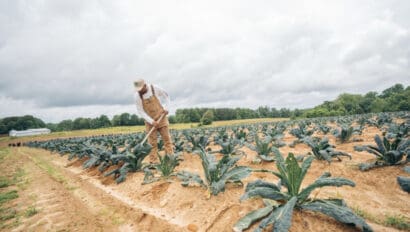Learning From Climate Action to Successfully Finance Biodiversity

Liesl Truscott, our Director of Industry Accountability and Insights, discusses market-based solutions for biodiversity, clarifying why it’s vital that we take the right approach.
In the face of societal crises, the belief that markets will find solutions on their own is simply untrue. Not without clear guardrails. Market incentives or rewards for more sustainable textiles are needed. But they must be guided by strict rules and governance that build and maintain trust and integrity.
Instead of relying on the market to self-regulate, the best priority for companies is to transition from business models that degrade, deplete, and pollute, towards business models that conserve, restore and regenerate.
That being said, the nature-market conversation is officially in full swing, creating opportunity to consider how we can best go about financing biodiversity. At the annual Davos World Economic Forum meeting in January, restoring ecosystems was on the agenda.
In the SDG Tent venue, Simon Zadek of NatureFinance discussed why and how we need the market to help reverse the biodiversity crisis. Highlighting the inherent positivity of focusing on biodiversity, Zadek said:
“Nature brings positive emotions and opportunities, while climate change fills us with dread and anxiety. That’s not to say that action for nature is any easier or less worrying… but part of the appeal is that it’s more about how to regenerate nature, rather than being about what we must stop.”
What’s more, since climate and nature are interconnected, our solutions cannot be narrow or isolated. Solving climate change means tending to the health of ecosystems too. For example, the UNFCCC estimates that natural sources such as forests, wetlands, mangroves, peatlands, and pastures can account for around a third of greenhouse gas removals.
This means we must consciously avoid “carbon tunnel vision”, instead approaching climate and nature in an integrated, inclusive way. This insight is at the heart of Textile Exchange’s Climate+ strategy, which merges climate goals with key impact areas like soil, water, and biodiversity, taking a holistic vision of success for the fashion, textiles, and apparel industry.
To avoid repeating mistakes, we can learn from climate frameworks, governance, and data
Carbon reporting has been underway for over a decade, with organizations like theScience-Based Targets initiative to the Taskforce on Climate-related Financial Disclosuresmaking real headway. Now that there’s an increased focus on doing the same for nature, it’s vital that we learn from climate and market responses.
Using a climate finance framework as a reference can kickstart momentum for nature, but there are a couple of key differences that cannot be overlooked. First, acting for nature will be driven by place-based needs, while climate targets are driven by a single temperature rise limit. Second, now that we know more about the intrinsic links between climate and nature, we must shift away from narrow, reductionist problem-solving, moving toward more holistic solutions instead.
Whether you agree with attaching markets to nature or not, there’s no disputing that more financing is needed to protect ecosystems, and this means doing away with harmful subsidies
According to a Paulson Institute report, there is a $700 billion annual gap in financing for biodiversity. Finance – whether from banks, investors, governments, funders, or philanthropists – needs to move in the same direction. We simply cannot condone financial incentives and subsidies that damage the environment by canceling out positive financial flows for nature and climate.
A 2022 study on subsidy reform, commissioned by The B Team and supported by Business for Nature, reviewed a range of environmentally harmful subsidies across sectors. They estimated that the world is spending at least $1.8 trillion a year – equivalent to 2% of global GDP – on subsidies that drive the destruction of ecosystems and species extinction.
It’s promising to see, therefore, that the new Global Biodiversity Framework (GBF), agreed at COP15 in Montreal in December 2022, includes finance goals. For example, there is Target 18: To eliminate, phase out or reform incentives, including subsidies harmful for biodiversity, while substantially and progressively reducing them by at least $500 billion per year by 2030. There’s also Target 19: Substantially and progressively increase thelevel of financial resources from all sources, including domestic, international, public, and private resources to implement national biodiversity strategies and action plans, by 2030 mobilizing at least $200 billion per year.
Aside from governments and other state actors, another powerful influencer is of course the investor community. This includes data providers such as CDP, who guide investment decisions. Put simply, these actors have substantial control over who gets the money and who doesn’t. Therefore, focusing on disclosing “investor-grade” data can open doors for financing nature-positive activities, as well as close the door on pollution, damage, and destruction. Textile Exchange is beginning to explore this potent mix between investor-grade data and biodiversity finance, plus how our benchmarking program can support companies on this link.
Bringing our economy within planetary boundaries requires a major shift in how financial rewards and penalties are issued to companies, as well as a wider group of stakeholders to share benefits
A growing number of organizations, including NatureFinance, the World Economic Forum, IIED, and The Biodiversity Consultancy, foresee “nature markets” as something that can be successful – providing they are properly set up and governed.
But what is the “nature market”? The Taskforce on Nature Markets (summarized in a recent McKinsey article) describes it as “a system composed of transactions between separate buyers and sellers, in which the transacted good or service specifically reflects a stock of ecosystem assets or a flow of ecosystem services from terrestrial or aquatic ecosystems.” The article emphasizes that the key will be market governance and infrastructure. This includes rules of trade, pricing mechanisms as well as systems of exchange and monitoring, reporting and verification.
Getting back to that finance gap for nature, Target 19 (d) of the GBF, noted a commitment to “stimulating innovative schemes such as payment for ecosystem services, green bonds, biodiversity credits, and benefit-sharing mechanisms”. Akanksha Khatri, Head of Nature and Biodiversity at the World Economic Forum, gave the following advice:
“Biodiversity credits are one of the market-based financial mechanisms that can unlock private finance by valuing ecosystem services and community benefits, beyond carbon. While the potential for impact is high, clear definitions and guardrails are urgently needed to ensure integrity, inclusivity, and transparency.”
Once again, can we learn from carbon and its potential misuse and abuse in the marketplace, to ensure that nature markets are scaled with integrity and credibility, delivering positive outcomes for nature?
Along with integrity and credibility, there must also be equity and inclusivity. It is vital that nature markets work to the advantage of Indigenous Peoples and Local Communities(IPLC), as these communities often hold critical knowledge and stewardship over biodiversity. The aim is to increase benefit sharing with IPLCs, and for companies to learn from those who uphold traditional and local knowledge. Not the other way around.
If you are reading this, you need no convincing about the urgency and gravity of the situation. This Davos session: Leading the Charge through Earth’s New Normal is a sobering reminder of what we face, and is well worth an hour of your day.
Have your say
Is your company exploring how to invest in nature conservation, restoration, or other nature-related activities? If so, how? What are the important ingredients we need to get right for financing nature to work?


